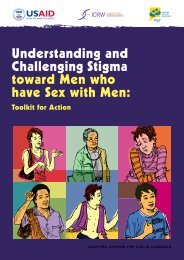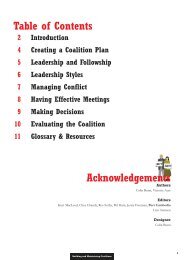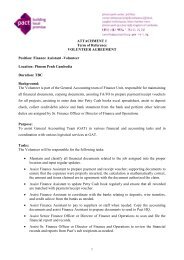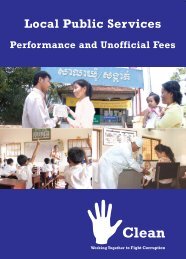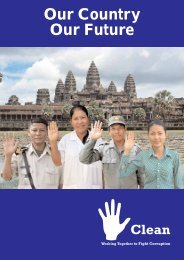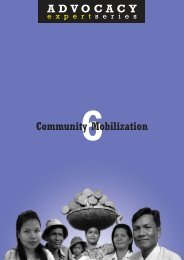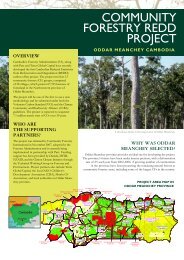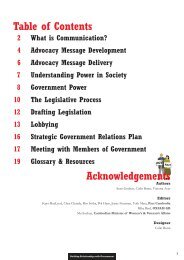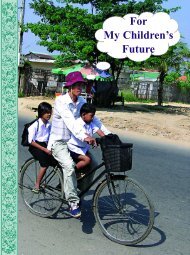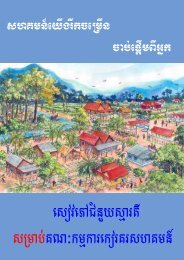Advocacy in Cambodia: Increasing Democratic ... - Pact Cambodia
Advocacy in Cambodia: Increasing Democratic ... - Pact Cambodia
Advocacy in Cambodia: Increasing Democratic ... - Pact Cambodia
You also want an ePaper? Increase the reach of your titles
YUMPU automatically turns print PDFs into web optimized ePapers that Google loves.
Timel<strong>in</strong>e of Land Issues Over the Past Seven Years<br />
Mid-1990s<br />
ADB’s process for consider<strong>in</strong>g a loan<br />
to <strong>Cambodia</strong> reveals the need for a new<br />
Land Law.<br />
1998 Cadastral Department <strong>in</strong> the Council of<br />
M<strong>in</strong>isters drafts a new Land Law.<br />
(Prior to 1995 the Cadastral Dept.<br />
fell under the MoA.)<br />
1998 Large demonstrations are held <strong>in</strong> Phnom<br />
Penh to protest land grabb<strong>in</strong>g.<br />
1998 Oxfam conducts its Land Study Project.<br />
Dec. 1998<br />
Land Law Work<strong>in</strong>g Group (LLWG) is<br />
formed.<br />
1998-9 As the secretariat for the LLWG, Oxfam<br />
provides feedback on the proposed new<br />
Land Law.<br />
Mar. 1999<br />
May 1999<br />
June 1999<br />
May 2001<br />
Aug. 2001<br />
Due to large demonstrations <strong>in</strong> front<br />
of the National Assembly and Senate,<br />
Council of M<strong>in</strong>isters creates a<br />
National Land Dispute Commission.<br />
NGOs present their revised draft Land<br />
Law to the Council of Jurists/Council<br />
of M<strong>in</strong>isters.<br />
Council of M<strong>in</strong>isters creates the<br />
M<strong>in</strong>istry of Land Management. Cadastral<br />
Dept. is transferred to MoLM.<br />
The Royal Government issues its<br />
statement on Land Policy.<br />
New Land Law is ratified.<br />
M<strong>in</strong>isters and discussed land issues<br />
and land legislation. Soon<br />
afterwards, <strong>in</strong> June 1999, the<br />
adm<strong>in</strong>istrative structure for land<br />
changed when the Council of<br />
M<strong>in</strong>isters created the M<strong>in</strong>istry of<br />
Land Management (MoLM). The<br />
cadastral department of the Council<br />
of M<strong>in</strong>isters was <strong>in</strong>tegrated <strong>in</strong>to the<br />
new m<strong>in</strong>istry and NGO advocates<br />
began collaborat<strong>in</strong>g with the new<br />
m<strong>in</strong>istry.<br />
Unfortunately, development of<br />
the orig<strong>in</strong>al and NGO-revised drafts<br />
stalled and the new M<strong>in</strong>istry began<br />
work<strong>in</strong>g on a new draft. Dur<strong>in</strong>g that<br />
time the land law work<strong>in</strong>g group<br />
cont<strong>in</strong>ued to meet. The new<br />
M<strong>in</strong>istry was will<strong>in</strong>g to share its<br />
draft and receive NGO comments,<br />
and did <strong>in</strong>corporate some NGO<br />
suggestions. Problems with<br />
translation occurred as the orig<strong>in</strong>al<br />
version of the document was <strong>in</strong><br />
French and translation <strong>in</strong>to English<br />
resulted <strong>in</strong> two versions that did not<br />
co<strong>in</strong>cide. When the draft was then<br />
translated <strong>in</strong>to Khmer, more<br />
problems with <strong>in</strong>terpretation arose.<br />
Eventually however, after work<strong>in</strong>g<br />
closely with the MoLM, all parties<br />
<strong>in</strong>volved were able to reach<br />
consensus on a f<strong>in</strong>al draft. The new<br />
Land Law was ratified <strong>in</strong> August<br />
2001, more than two years after the<br />
M<strong>in</strong>istry was established, while<br />
demonstrators stood outside the<br />
National Assembly.<br />
2001-2 WB Land Title Registration Project<br />
preparation beg<strong>in</strong>s.<br />
2001-2 MoLM beg<strong>in</strong>s draft<strong>in</strong>g sub-decree to<br />
create a new Cadastral Commission to<br />
replace exist<strong>in</strong>g Land Dispute<br />
Resolution Committees.<br />
Assembly and Senate, their compla<strong>in</strong>ts were<br />
forwarded to the land dispute commissions, but<br />
this process was generally considered to be<br />
<strong>in</strong>effective. As a result, NGOs began help<strong>in</strong>g<br />
villagers file their compla<strong>in</strong>ts.<br />
In May 1999, the NGO draft of the land law<br />
was presented to the deputy chair of the Council<br />
of Jurists at the Council of M<strong>in</strong>isters. NGOs<br />
presented their draft twice to the Council of<br />
Resolution of Land Disputes<br />
Despite the existence of a land<br />
dispute resolution commission, the<br />
overwhelm<strong>in</strong>g view of civil society<br />
is that the land law has not been<br />
enforced. Prov<strong>in</strong>cial NGOs regularly<br />
cite land disputes as one of the top<br />
two problems experienced by rural<br />
communities. There has been a<br />
marked <strong>in</strong>crease <strong>in</strong> the number of<br />
land and natural resource<br />
violations, due to the fact that <strong>Cambodia</strong> is<br />
undergo<strong>in</strong>g a massive economic change. Land is<br />
<strong>in</strong>creas<strong>in</strong>g <strong>in</strong> value and the political and economic<br />
spheres cont<strong>in</strong>ue to feed the patronage network.<br />
The <strong>Cambodia</strong>n government simply has not had<br />
a strong enough structure to deal with the<br />
powerful forces of change.<br />
Legal Aid of <strong>Cambodia</strong> (LAC) conservatively<br />
Case Studies<br />
55




